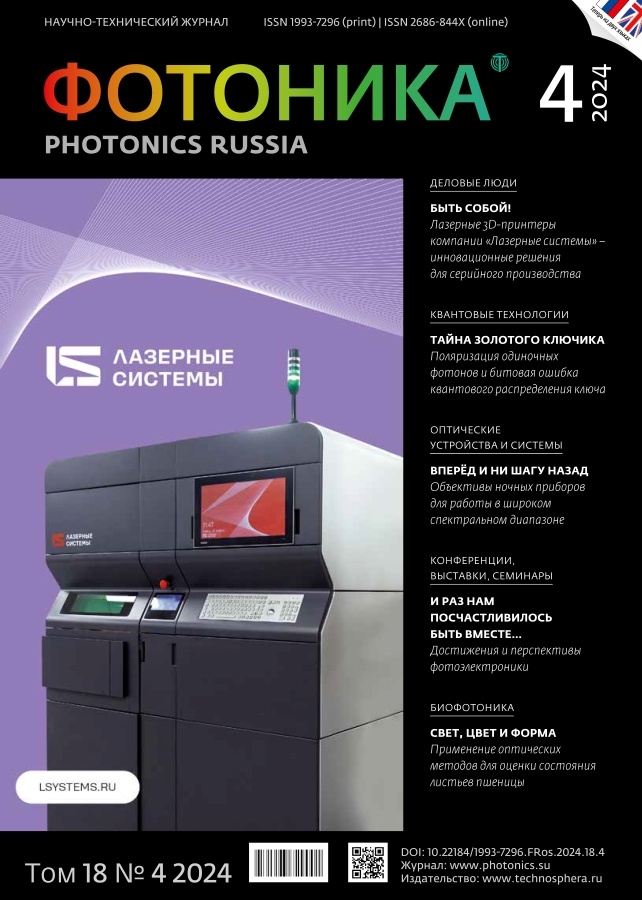Influence of quantum state fidelity of a single photon source on the bit error rate in quantum key distribution
- Authors: Frolovtsev D.N.1, Demin A.V.2
-
Affiliations:
- Lomonosov Moscow State University
- All-Russian Research Institute of Optical and Physical Measurements (VNIIOFI)
- Issue: Vol 18, No 4 (2024)
- Pages: 282-294
- Section: Quantum Technologies
- URL: https://journals.eco-vector.com/1993-7296/article/view/634532
- DOI: https://doi.org/10.22184/1993-7296.FRos.2024.18.4.282.294
- ID: 634532
Cite item
Abstract
The paper analyzes the efficiency of a quantum state fidelity to assess the raw bit error value introduced by the polarization state of a single photon source. The analysis was performed for the quantum key distribution schemes BB84 and BBM92. It has been shown theoretically and experimentally that when the fidelity is decreased from 1 to 0 in the BB84 scheme, the raw bit error value linearly increases from 0 to 1, and in the BBM92 scheme – from 0 to 1/2. The experimental setups for determine the influence of fidelity on the bit error value are described in detail.
Full Text
About the authors
D. N. Frolovtsev
Lomonosov Moscow State University
Author for correspondence.
Email: photonics@technosphera.ru
Researcher, Faculty of Physics
Russian Federation, MoscowA. V. Demin
All-Russian Research Institute of Optical and Physical Measurements (VNIIOFI)
Email: photonics@technosphera.ru
Cand. of Technical Sciences, Researcher
Russian Federation, MoscowReferences
- Vaughan O. A platform for quantum computing. Nature Electronics 6, no. 5 (2023): 337–337. doi: 10.1038/s41928-023-00974-4.
- Fldzhyan S. A., Saygin M.Yu., Kulik S. P. Programmable heralded linear optical generation of two-qubit states. Physical Review Applied 20, no. 5 (2023): 054030. doi: 10.1103/PhysRevApplied.20.054030.
- Wang J., Sciarrino F., Laing A., Thompson M. G. Integrated photonic quantum technologies. Nature Photonics 14, no. 5 (2020): 273–284. doi: 10.1038/s41566-019-0532-1.
- Struchalin G. I., Zagorovskii Ya.A., Kovlakov E. V., Straupe S. S., Kulik S. P. Experimental estimation of quantum state properties from classical shadows. PRX Quantum 2, no. 1 (2021): 010307. doi: 10.1103/PRXQuantum.2.010307.
- Moiseev E. S., Tashchilina A., Moiseev S. A., and Sanders B. C. Broadband quantum memory in a cavity via zero spectral dispersion. New Journal of Physics 23, no. 6 (2021): 063071. doi: 10.1088/1367-2630/ac0754.
- Kalash M., Chekhova M. V. Wigner function tomography via optical parametric amplification. Optica 10, no. 9 (2023): 1142–1146. doi: 10.1364/OPTICA.488697.
- Mironov Y. B., Kazantsev S. Y., Shakhovoy R. A., Kolesnikov O. V., Mashkovtseva L. S., Zaitcev A. I., Korobov A. V. Analysis of single photon sources with quantum key distribution systems development prospects. H&ES Reserch. 2021;13(6):22–33. doi: 10.36724/2409-5419-2021-13-6-22-33.
- Миронов Ю. Б., Казанцев С. Ю., Шаховой Р. А., Колесников О. В., Машковцева Л. С., Зайцев А. И., Коробов А. В. Анализ перспектив развития источников одиночных фотонов в системах квантового распределения ключей. Наукоемкие технологии в космических исследованиях Земли. 2021;13(6):22–33. doi: 10.36724/2409-5419-2021-13-6-22-33.
- Shu H. Solve single photon detector problems. Quantum. 2023 Nov 21;7:1187. doi: 10.22331/q-2023-11-21-1187.
- Reutov A, Tayduganov A, Mayboroda V, Fat’yanov O. Security of the decoy-state BB84 protocol with imperfect state preparation. Entropy. 2023 Nov 17;25(11):1556. doi: 10.3390/e25111556.
- Chunnilall CJ, Degiovanni IP, Kück S, Müller I, Sinclair AG. Metrology of single-photon sources and detectors: a review. Optical Engineering. 2014 Aug 1;53(8):081910. doi: 10.1117/1.OE.53.8.081910.
- Waks E, Santori C, Yamamoto Y. Security aspects of quantum key distribution with sub-Poisson light. Physical Review A. 2002 Oct 22;66(4):042315. doi: 10.1103/PhysRevA.66.042315.
- Grangier P, Roger G, Aspect A. Experimental evidence for a photon anticorrelation effect on a beam splitter: a new light on single-photon interferences. Europhysics Letters. 1986 Feb 15;1(4):173. doi: 10.1209/0295-5075/1/4/004.
- ETSI standard. ETSI GS QKD 011 V1.1.1 (2016-05), Quantum Key Distribution (QKD); Component characterization: characterizing optical components for QKD systems. URL: https://www.etsi.org/deliver/etsi_gs/QKD/001_099/011/01.01.01_60/gs_QKD011v010101p.pdf
- Jozsa R. Fidelity for mixed quantum states. Journal of modern optics 41, no. 12 (1994): 2315–2323. doi: 10.1080/09500349414552171.
- Bennett C. H., Brassard G. An update on quantum cryptography. In Workshop on the theory and application of cryptographic techniques, pp. 475–480. Berlin, Heidelberg: Springer Berlin Heidelberg, 1984. doi: 10.1007/3-540-39568-7_39.
- Bennett C. H., Brassard G., Mermin N. D. Quantum cryptography without Bell’s theorem. Physical review letters 68, no. 5 (1992): 557. doi: 10.1103/PhysRevLett.68.557.
- Kulik S. P. Quantum cryptography. Photonics Russia. 2010;4(2):36–41. Кулик С. П. Квантовая криптография. ФОТОНИКА. 2010;4(2):36–41.
- Wootters W. K., Zurek W. H. A single quantum cannot be cloned. Nature 299, no. 5886 (1982): 802–803. doi: 10.1038/299802a0.
- Lo H.-K., Ma X., Chen K. Decoy state quantum key distribution. Physical review letters 94, no. 23 (2005): 230504. doi: 10.1103/PhysRevLett.94.230504.
- Couteau C. Spontaneous parametric down-conversion. Contemporary Physics 59, no. 3 (2018): 291–304. doi: 10.1080/00107514.2018.1488463.
- Kwiat P. G., Waks E., White A. G., Appelbaum I., Eberhard P. H. Ultrabright source of polarization-entangled photons. Physical Review A 60, no. 2 (1999): R773. doi: 10.1103/PhysRevA.60.R773.
- Altepeter J. B., Jeffrey E. R., Kwiat P. G. Phase-compensated ultra-bright source of entangled photons. Optics Express 13, no. 22 (2005): 8951–8959. doi: 10.1364/OPEX.13.008951.
- Rangarajan R., Goggin M., Kwiat P. G. Optimizing type-I polarization-entangled photons. Optics express 17, no. 21 (2009): 18920–18933. doi: 10.1364/OE.17.018920.
- Frolovtsev D. N., Magnitskii S. A., Demin A. V. Measurement Method of the Polarization-Entangled States of Biphotons Using a Quantum Tomograph. Measurement Techniques 64, no. 10 (2022): 809–816. doi: 10.1007/s11018-022-02008-5. Фроловцев, Д.Н., Магницкий С. А., Демин А. В. Методика измерений поляризационно-запутанных состояний бифотонов с помощью квантового томографа. Измерительная техника 10 (2023): 21–27. doi: 10.32446/0368-1025it.2021-10-21-27.
- Pathak N. K, Chaudhary S, Sangeeta, Kanseri B. Phase encoded quantum key distribution up to 380 km in standard telecom grade fiber enabled by baseline error optimization. Scientific Reports. 2023 Sep 22;13(1):15868. doi: 10.1038/s41598-023-42445-y.
- Spedalieri F. M. Quantum key distribution without reference frame alignment: Exploiting photon orbital angular momentum. Optics communications. 2006 Apr 1;260(1):340–6. doi: 10.1016/j.optcom.2005.10.001.
Supplementary files










